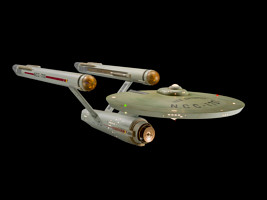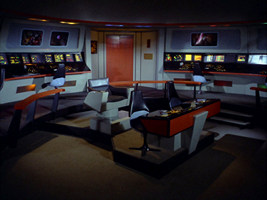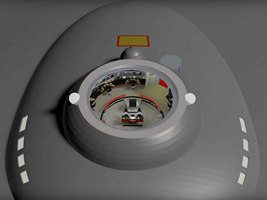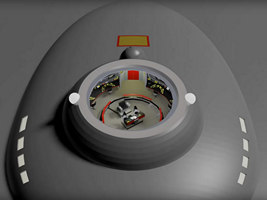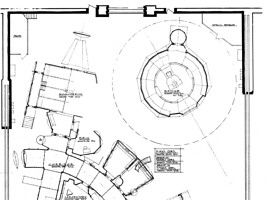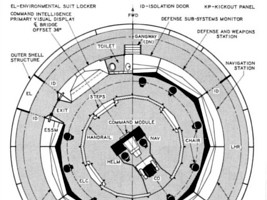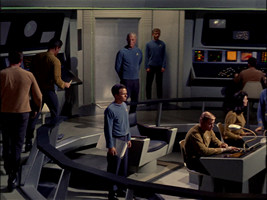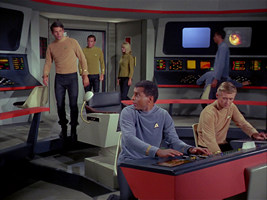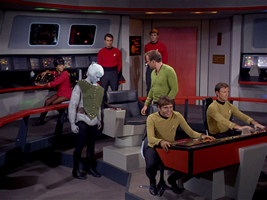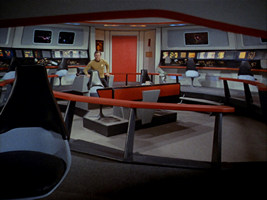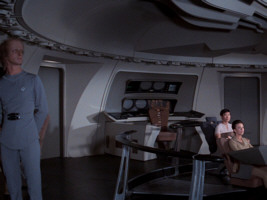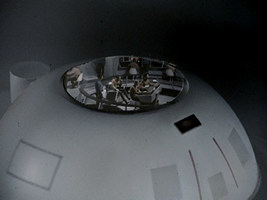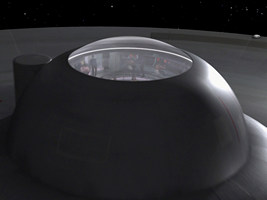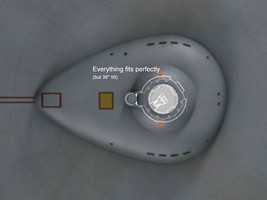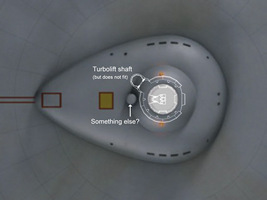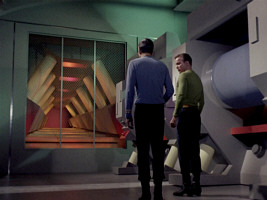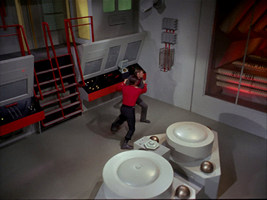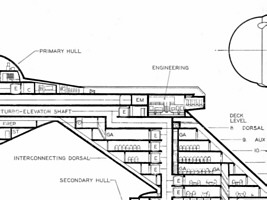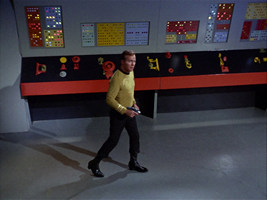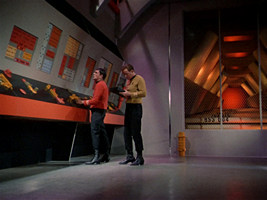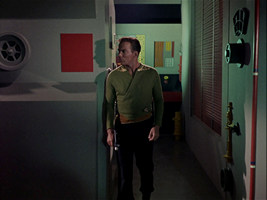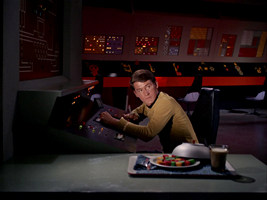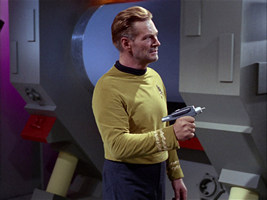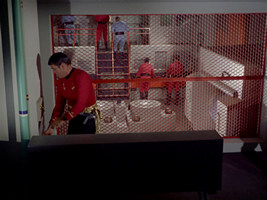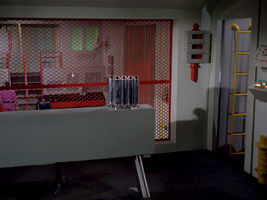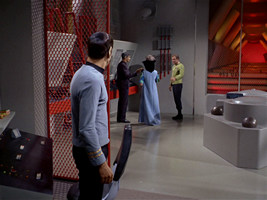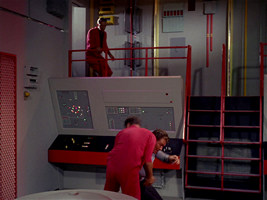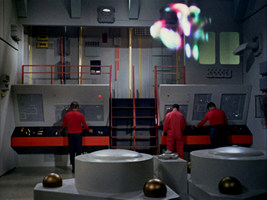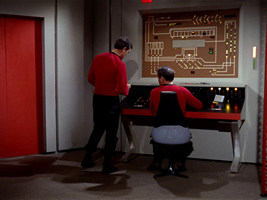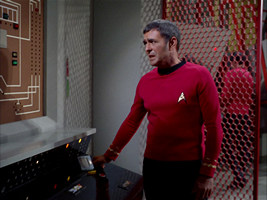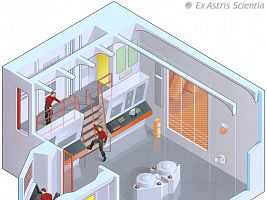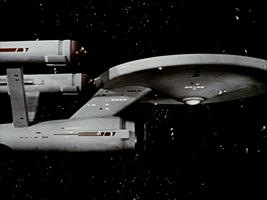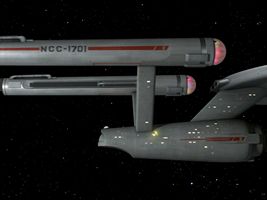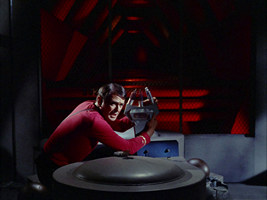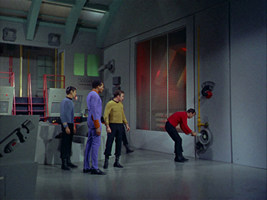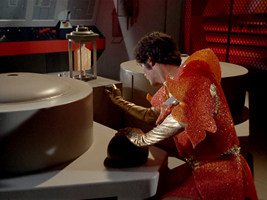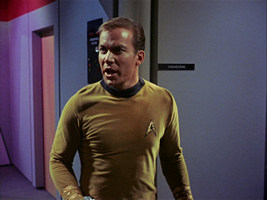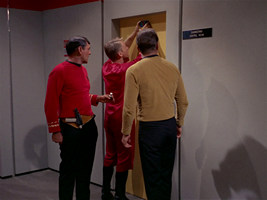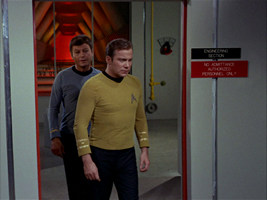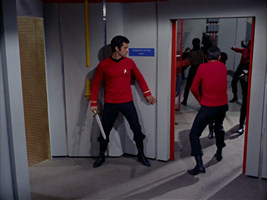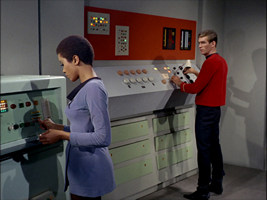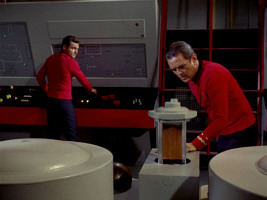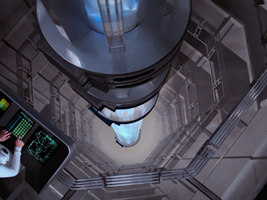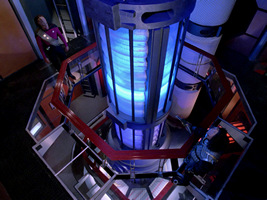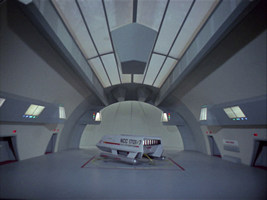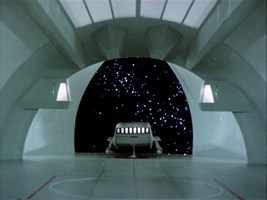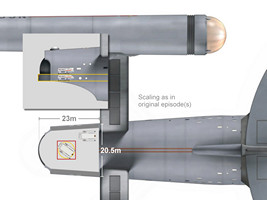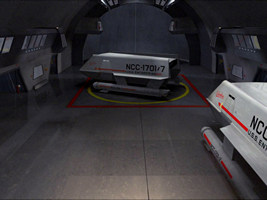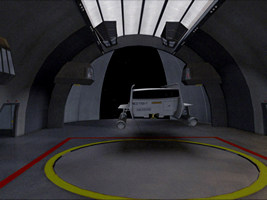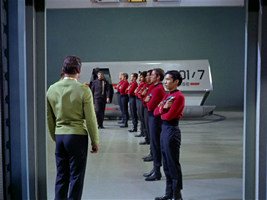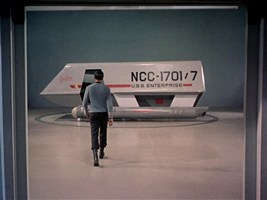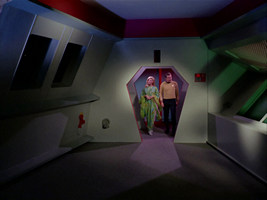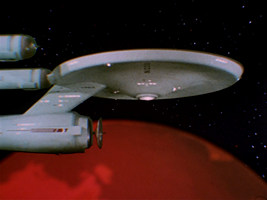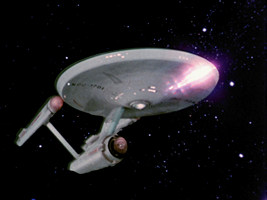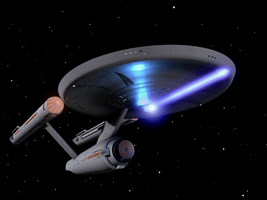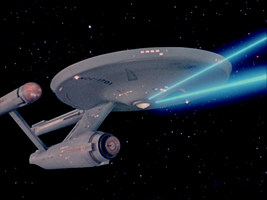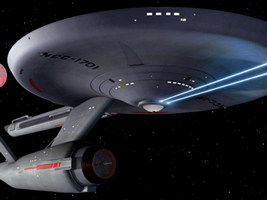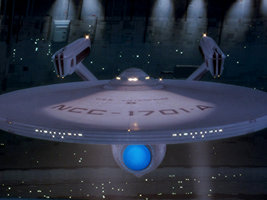Design Issues of the Original Enterprise
Bridge OrientationMain Engineering LocationOther Design IssuesAddendum: Saucer Separation
 The DIS/SNW reboot of the Enterprise is not discussed here. See the database on Discoverse Federation Ship Classes.
The DIS/SNW reboot of the Enterprise is not discussed here. See the database on Discoverse Federation Ship Classes.The article discusses problems or uncertainties about the design of the original Enterprise by Matt Jefferies, as it appeared in TOS. The refit of 2271 is already covered on a separate page.
Bridge Orientation
Preface
One of the most contentious original Enterprise design oddities is the orientation of the bridge, whose viewscreen may not face forward. The bridge has only a single turbolift access. It is located at the port side, having an offset of 36 degrees relative to the centerline of the bridge set. The turbolift shaft, on the other hand, is placed in the centerline of the ship, as indicated by the hull protuberance on deck 1 of the ship model. So the seats of Kirk, Sulu and Chekov may not be facing forward. At least, that is what the Star Fleet Technical Manual proposes as soon as in 1975.
Another problem of the bridge design is that there is only one turbolift as the only way to get in and out, which seems like a stupid lack of redundancy.
Set and model design
The bridge set was built on Desilu's Stage 9 (nowadays: Paramount Stage 31). It was not connected to any corridor and could be accessed only through the single turbolift. The turbolift interior could be moved to other parts of the stage for that purpose. Stage 9 measures 145'-1" (44.2m) by 106'-9" (32.3m). Assuming that the set plan is exactly to scale, this gives us a diameter of the bridge of merely 9.1 meters (30') overall and 7.9 meters (26') clear space between the console edges. The plans in the Star Fleet Technical Manual assume as much as 12.0 meters for the former and 9.3 meters for the latter, which is clearly way too large.
There are overall ten wall segments. If we measure the angles on the set plan, the segment with the main viewer occupies 40.5°, leaving 35.5° for each of the other nine walls. The angles on the STTM plans are all 36°. For the purpose of this article, I will also go with this simplification. Kirk's captain's chair, the helm/navigator console and the main viewscreen are aligned on the centerline of the set. Uhura is sitting right behind Kirk, facing in the opposite direction. The turbolift door is located one wall segment to port, and hence has an offset of 36° from the centerline of the bridge.
Actually, after the set already had the 36° offset in "The Cage", it looks like in "Where No Man Has Gone" it was halved to half a segment or approx. 18°. More precisely, nothing was changed about the partitions, but the outer segments were simply rotated 18° counter-clockwise around the core since "The Cage", with the viewscreen now being 18° to the left of the command chair axis. After that, it was decided to return to 36°, which remained consistent throughout the series. Yet, at some point before the production of the series started, it may still have been considered to put the turbolift into the aft center of the bridge. The Making of Star Trek from 1968 provides a list of the stations. They are numbered from 1 to 4 both on the port and on the starboard side, which means the turbolift would have to be in the center.
A frequently cited rationale for the 36° offset is that it was deemed better to film if people wouldn't enter the bridge right behind Kirk. On the other hand, face-on shots of the captain's chair such as in "The Corbomite Maneuver" are not very common in the series. Another reason that has been brought forward is that the segments to the right of the viewscreen were removable to film wide shots of the bridge, and to cover the four wall sections that were deemed most interesting: Spock's console, Uhura's console, the turbolift and Scott's console (as seen by the camera, from left to right). This configuration was deemed advantageous because the turbolift would be up-stage, rather than on the left of the TV screen. This placement of the turbolift resulted in plenty of scenes in which someone entered right behind Kirk, which contradicts the alternative rationale.
The USS Enterprise is 289m long. Using the CG model created for Eaglemoss as a reference, the outer diameter of deck 1 is 13m at the base. The single turbolift shaft is on the aft on the ship's centerline. The bridge with the dimensions as in the STTM would not fit in. Even without the additional corridor around the known set that the book proposes the set would be much too large.
A perhaps more serious issue of the bridge design is that the single turbolift is the only possible access (at least, the only access ever shown). There is no second door. If anything, we may imagine that some auxiliary or emergency exit could be located next to the viewscreen as indicated on the STTM floorplan (as well as a toilet on the other side, which is arguably very important too).
 In TAS, the problem of the Enterprise having only one bridge access was fixed. A second turbolift was added to the left of the viewscreen. It is not visible on the outside, however.
In TAS, the problem of the Enterprise having only one bridge access was fixed. A second turbolift was added to the left of the viewscreen. It is not visible on the outside, however.
The Enterprise refit of 2271 has two turbolifts, which are located in the angular bridge aft section that also contains a docking port.
Evidence
The only visual evidence of the bridge orientation can be found as soon as in the opening shot of "The Cage". In the original as well as in the remastered episode the captain's chair is facing forward and the turbolift door would more or less lead into open space.
Regarding the availability of turbolift cars on the bridge, we can easily imagine that sooner or later there should be a situation in which someone has just left the bridge, and someone else has to wait for the next car to arrive. This actually happens as soon as in "The Naked Time". After two crewmen have left to take the nerve-pinched "D'Artagnan" Sulu to sickbay, Kirk receives note that Riley has taken over engineering. He bumps into the door of the lift that won't open because there is no car yet. He tells Uhura to "Clear that tube".
In "Space Seed", the turbolifts are inoperative, but this is because of Khan's sabotage and does not allow to draw conclusions about the bridge design - although we may argue they could use the emergency exit if there were one.
On the other hand, we also have the situation in which Lazarus enters the turbolift in "The Alternative Factor" and only three seconds later a security guard follows him. We can't see him but Lazarus could be still inside. Yet, the visitor is later seen exiting the turbolift alone. Kirk says in his log and to Lazarus that "two of my crewmen were attacked", obviously referring to the two Lazarus later assaulted in the dilithium control room, not the guard. So this is a hint that a second turbolift car may have been on standby.
Options
So how can we arrange the bridge and the turbolift to make the most sense?
- Option 1: If we assume the turbolift as integrated into the set is identical to the bump visible on the outside, the bridge could be perfectly centered in deck 1. However, then the viewscreen would face 36° to port. Many fans have accepted it since the idea was popularized in the STTM. Is it a problem at all? Classic Trek knows no bridge windows, and there is no canon evidence except for the somewhat "unreal" shot in "The Cage" that would require to have the bridge perfectly aligned with the ship's centerline. But considering that the crew may feel acceleration of the ship and other forces on the hull to some extent (not to mention weapons fire that often rocks the bridge), we probably wouldn't want to have such an offset. Design-wise, it would be the logical choice to have the viewscreen facing forward.
- Option 2: If we try to superimpose the bridge on deck 1 in a way that the viewscreen faces forward, the turbolift would be located outside the 13m diameter of the deck even at the base. It also would have to slide a few meters sideways upon arriving on deck 1, which is unnecessarily complicated. Well, unless the turbolift shaft is off-axis and not underneath the protuberance as visible on the outside.
- Option 3: One thing we could do to compensate is move the whole bridge set forward inside deck 1, so the turbolift would be (barely) inside the 13m diameter. Even if it fits at the base now, the height may not be quite sufficient, but we may imagine it is possible. Also, the bridge could be slightly submerged into deck 2 to make it possible. The location of the bridge inside deck 1 looks a bit awkward now. Yet, we may argue that there is space for more than one turbolift car on deck 1. The one that can be boarded moves to the port side and a spare car to the starboard side. Once the port car is underway, the starboard car moves to port. This could alleviate the situation of only one bridge access a bit and may explain what happened in "The Alternative Factor".
Conclusion
It probably remains a matter of taste whether we want the interior to correspond perfectly with the exterior at the cost of the bridge being rotated, or whether we make a few compromises regarding the structure to align the bridge properly (and possibly have a spare turbolift car available on deck 1).
Main Engineering Location
Preface
The location of the engine room on the Enterprise was not clearly established in The Original Series. There are many cues but never an explicit reference to the deck where it is located (at least none that proves trustworthy). From today's standpoint it seems reasonable that engineering is in the secondary hull. But early reference works, starting with Franz Joseph's Star Fleet Technical Manual, place it into the saucer section, right in front of the impulse engines. This also applies to the Star Trek Blueprints by the same author.
For the purpose of this chapter, I will refer to the very room as "engineering" (not "main engineering") and to the hull section of the ship as "secondary hull" (not "engineering section") for reasons that will still be explained.
Set design
The engineering set was built on Desilu's Stage 9, like most of the Enterprise sets. It was connected to other rooms such as sickbay or the transporter room via the curved corridor. Upon entering the set in its original configuration, a long console occupied the whole left wall. Straight ahead there was a large opening with a hexagonal grating, behind which an arrangement of yellow tubes could be seen. The latter were built using a forced perspective, thus giving the impression they were much longer than in reality. When the engines were active, the tubes were illuminated, giving the semblance of a glow. On the right, angular blocks of machinery were located, with embedded large tubes. Their purpose was never identified. The set was modified for each appearance in season 1 and even the large blocks were moved around just as needed to get the best camera angle, which to investigate would be beyond the scope of this chapter.
It is worth noting that no one was usually working in engineering in season 1. The set appeared in a couple of episodes, most notably in "The Enemy Within", "The Naked Time", "Court Martial" and "Space Seed". In "The Enemy Within" and "Court Martial" it has story relevance that the section can be used as a hiding place by Evil Kirk and Ben Finney, respectively. Also, in "The Naked Time" it is easy for Riley to lock himself up because no one else is in the room. Finally, in "The Conscience of the King" Kirk (somewhat ironically in light of what happened in "The Naked Time") assigns Riley to engineering, apparently because he thinks his man wouldn't run into Kodos when working in a remote and usually empty part of the ship.
The set was substantially remodeled as soon as for season 2. An upper level, containing the emergency manual monitor, was added in the right half to provide more opportunities for action. The long console on the left was split apart to create access to another upper level. Also, the big blocks were removed, although one of them occasionally shows up as seen from the emergency manual monitor, such as in "Mirror, Mirror". The dilithium chamber was added in the center of the set. A small new foyer is separated from the main room by a red grating. It contains the console with the "printed circuit board"-style display that was previously located on the wall opposite to the large window (we could see Riley working there in "The Conscience of the King"). From now on, there are always crew members present in engineering.
The accordingly remodeled set can be seen in a large number of episodes, such as "The Doomsday Machine", "The Changeling", "Mirror, Mirror", "I, Mudd", "Journey to Babel", "The Immunity Syndrome", "By Any Other Name", "The Ultimate Computer", "Elaan of Troyius", "The Paradise Syndrome", "Is There in Truth No Beauty?", "The Tholian Web", "Day of the Dove", "That Which Survives", "The Lights of Zetar". It remains largely consistent in all of these appearances.
Evidence
As verbal references and story logic are concerned, there are various pieces of evidence. In "Where No Man Has Gone Before" an "engineering deck 3" is mentioned, which sounds more like there are three engineering decks, not like engineering is on deck 3. In "The Ultimate Computer", Scotty attempts to override M-5's controls from "engineering level 3", but we are not shown where the Jefferies tube with the label "Engineering Circuit Bay G-121" he is working in is located relative to the engine room with M-5. In "The Corbomite Maneuver", during a battle simulation, Bailey makes announcements through the intercom in quick succession, one of which is: "Engineering, deck five, report." This may be taken as evidence for engineering being on deck 5. Then again, considering how brief he keeps all of his requests, it is a bit more reasonable that he wants engineering and deck 5 to report. According to "Court Martial", engineering is on B deck. This can't be the same as deck 2, not only because otherwise deck numbers are used in TOS, but most importantly because deck 2 is right under the bridge, which is most definitely not a suited place. So perhaps B deck is the second deck from the top in the secondary hull?
Overall, engineering more or less consistently appears to be somewhere on the lower decks of the ship. When Riley has locked himself up in "The Naked Time", Scott tells a crewman "Get up to my office and pull the plans for this bulkhead." Well, this merely implies that the chief engineer's office is at least one deck above. But there are better examples. Good Kirk and Spock deem "the lower levels - the engineering deck" a good place for Evil Kirk to hide in "The Enemy Within". In "The Conscience of the King" it is mentioned three times that Riley is working "down" in engineering (although we may argue that relative to the bridge everything on the ship is "down"). In "The Doomsday Machine", Scotty is located in the familiar engine room set, now representing the USS Constellation, while Kirk is in the ship's auxiliary control room. Kirk says: "Set it [detonation device] and get up here as fast as you can." It would be a bad choice to put the auxiliary control room close to the bridge. In fact, it is on deck 8 on the Enterprise as mentioned in "I, Mudd", so this also speaks for engineering in the secondary hull.
In "Day of the Dove", engineering is referred to as being "down" yet again. But this time there is a problem because there are also "almost 400 crewmen" trapped on still lower decks after the bulkheads were closed (because the entity wants to maintain a balance of power with the Klingons). So if engineering is in the secondary hull, the vast majority of the crew would have to be at the very bottom of the ship for some reason, to be locked up there. These references make more sense if engineering is in the saucer, unless we come up with a rationale why it is accessible while the rest all around it is closed up. There are a couple more issues with the topology of the ship in this episode, which may or may not have an impact on our question but to discuss which would go beyond the scope of this investigation.
Actually, "Day of the Dove" also provides us with the only visual evidence of where in the hull engineering is very likely located. At the end of the episode, the entity exits from the upper level of the engine room and can then be seen leaving the ship through the secondary hull underneath the neck. In TOS-R, this spot was moved back in front of the nacelle pylons. Although it doesn't seem to take the shortest path to open space but goes through a door that likely leads aft, it seems unlikely that the entity would first cross the neck and then leave the ship.
As already mentioned, the curved main corridor set is directly attached to engineering. But we could never see anyone walking straight from sickbay or the transporter room to engineering or back. Still, it may be a reason to assume it is in the saucer section, as the curved layout would not make much sense in the narrow secondary hull.
There are various pieces of evidence linking the set to the kind of power or of engines that are visible or that may be accessible from there. In "The Doomsday Machine", as already mentioned, Scotty is working in the engine room of the USS Constellation and is talking to Kirk in the auxiliary control room. The warp drive is beyond repair, but Scotty suggests to activate (and later overload) the impulse engines. He can be seen in front of the forced-perspective tubes. At one point he speaks of "these impulse engines", which seems to refer to the tubes behind him. Also, this section lights up once he has brought back impulse power. So are these the impulse engines, and engineering is in the saucer? Perhaps. But we also have to keep in mind that he is clearly working on the dilithium chamber, as it would be established in "Elaan of Troyius". This could be rated as an error because this is arguably not a part of the impulse power system he is allegedly repairing. For the purpose of our investigation, he may be bypassing the warp core to make sure that all systems of the ship are supplied with plasma from the impulse engines.
When M-5 is to be disconnected from power in "The Ultimate Computer" and a crewman is working on some sort of wall socket in engineering, the computer establishes a plasma connection with this socket, thereby killing the poor redshirt. Spock notes: "M-5 appears drawing power directly from the warp engines, tapping the matter-antimatter reserves." So this is a clear hint we are in the secondary hull. "Elaan of Troyius" is the first episode (in production order) to link warp engines and matter-antimatter reaction to dilithium (which is now housed in the bulky structures in the center of the engine room). "The Paradise Syndrome" shows the dilithium frame again and has more proof that the tubes are part of the warp drive (or warp power system). As the Enterprise catches up with the asteroid at high warp to deflect it soon enough, Scotty looks in worry at the tube assembly, which is glowing red, and says "I can't give you warp nine much longer, Mister Spock. These engines are beginning to show signs of stress." Later, as Spock keeps firing phasers at the asteroid and sparks are flying, Scotty famously bemoans the state of the engines with the words "My bairns. My poor bairns.".
The designation "main engineering" is never used in TOS. The facility is verbally referred to as "engineering", "engineering deck(s)", "engineering section" or "engineering department". There is a corridor label "Engineering" in "Court Martial" and probably in other season 1 episodes. The door label of the very room reads "Engineering Control Room" in "The Naked Time" and "Court Martial". It is "Engineering Section" since season 2 and "Engineering Officer Scott" in "Day of the Dove" for some reason. We probably shouldn't make the mistake and equate "engineering section" with what it means in modern Trek, as another name for the secondary hull (which contains more departments besides engineering). A specific door label saying "Engineering Section" inside the so-named engineering section just wouldn't make sense.
Further considerations
In addition to the principal engineering set, we can see the room where the dilithium is stored in "The Alternative Factor". This room is occasionally referred to as "dilithium control room" (at least, that's how I like to call it) but is named and labeled in the very episode as "Engineering". Having multiple identical door labels "Engineering" for different rooms isn't useful but is one of the smaller problems. Other possible parts of engineering that we see in TOS include the phaser control room in "Balance of Terror" and environmental engineering in "Wink of an Eye". But these two rooms could be located elsewhere on the Enterprise and don't have to be anywhere near the engine room. Ultimately, with so many "engineerings" on the Enterprise, it wouldn't be far-fetched to assume that some mentions do not refer to the engine room that this chapter is about, even though the ambiguity doesn't sound like a good idea.
Speaking of dilithium, in "Where No Man Has Gone Before" it is still referred to as lithium, which was changed in the course of season 1 because lithium is a real-world element that should not be attributed exotic properties. We know that the ship runs on a matter-antimatter reaction since "The Naked Time". The role that dilithium plays in power generation, if it isn't the actual power source, initially remained blurry. "The Alternative Factor" still creates the impression it stores power, whereas "Elaan of Troyius" and "The Paradise Syndrome" establish the modern view that dilithium crystals are the key component to regulate the matter-antimatter reaction.
An engineering set with the familiar warp core first appears in the refitted Enterprise in "Star Trek: The Motion Picture". Similar warp core designs can be seen pretty much every time an engine room of a later ship appears, such as of the Enterprise-D (actually a redress of the Enterprise refit set) or of Voyager, as well as of Enterprise NX-01. We know that the warp core should be located somewhere between the nacelles (and definitely not in the saucer section) on all those ships for the plasma conduits to make sense.
Conclusion
So what does this mean with regard to the location of the engine room on the original Enterprise? One possible rationale for the Star Fleet Technical Manual to place engineering into the saucer was that the glowing tubes in the background look like they could be the impulse engines, as it seems to be confirmed in "The Doomsday Machine". On the other hand, they also resemble the power transfer conduits as they are commonplace since "Star Trek: The Motion Picture". With the dilithium chamber, as it exists since season 2, being located just in front of these tubes, it is a lot more plausible for engineering to be in the secondary hull. It would also mean that some of the ship's power architecture may have been retained when the Enterprise was rebuilt in 2271, although the warp core of the Enterprise refit is definitely all-new and is vertical, as opposed to the one of the original ship, which would have to be horizontal (as on NX-01) and partially underneath the floor of engineering, if anything. Yet, even though it all mostly fits together, we still have to wonder why the dilithium chamber was so far away and so much different in season 1.
Overall, the evidence for engineering to be in the secondary hull is more numerous and more conclusive.
Other Design Issues
Shuttlebay size
There is some discussion whether the shuttlebay miniature built to film the launch and landing sequences matches with the established sizes of the Galileo 7 shuttle (6.7 meters long) and of the Enterprise (289 meters). Especially the obvious scale discrepancy between the original and the remastered scenes raises the question which of the two is correct. Also, is it possible to store four shuttles on the Enterprise and where?
The original shuttlebay miniature was built by Richard C. Datin. Star Trek: Communicator quoted him in 2001 explaining how the starboard side of the miniature was supposed to be removable to film it from more than one side: "However, for whatever reason, the starboard wall was not made to be removable and filming of the miniature could only be done looking back to the clamshell bay doors." That explains why in all scenes involving this model we are looking in the direction of the doors. In fact, there is only one launch sequence (first seen in "The Galileo Seven") and one arrival sequence ("Journey to Babel"). Overall, the shuttlebay appears in these two episodes, plus stock footage in "The Doomsday Machine", "The Immunity Syndrome" and "Let That Be Your Last Battlefield".
The available length for the shuttlebay is 23 meters, measured from the trailing edge of the nacelle pylons to the clamshell doors. The maximum width just behind the pylons is 20.5 meters, with the hull being tapered and measuring still 3 meters less on the aft end. As we overlay the shuttle and Enterprise top views with correct relative scales and sketch up how the set and especially the floor markings of the turntable look in the original episode, we can see that it is approximately in agreement. The shuttlebay could need one or two more meters both in terms of width and length. But overall the scale feels right. Even the lateral corridors would fit in. We may also place as many as three shuttles between the turntable and the inner door, if desired.
 Anyway, new computer-generated shuttlebay shots were created for TOS-R. These fix some registry issues but also change the scaling in an odd way. The Galileo 7 grows by about 30% in length relative to the rest, as does the turntable. Also, in the new shot created for TOS-R: "The Galileo Seven" and "Journey to Babel" (not in the other episodes), we can see a second shuttle NCC-1701/2 between the turntable and the inner shuttlebay access. So either the shuttle was scaled up, or the usable space of the shuttlebay was slimmed down. The first is true, as the shuttle is now one full deck high! We can see it would barely clear the underside of the observation corridor balcony, if at all. Perhaps this was done because the Galileo 7 used to be bigger on the inside than outside. But then the scenes involving the merely 2.2m high full-scale mock-up, where the discrepancy is a lot more obvious, ought to have been fixed as well.
Anyway, new computer-generated shuttlebay shots were created for TOS-R. These fix some registry issues but also change the scaling in an odd way. The Galileo 7 grows by about 30% in length relative to the rest, as does the turntable. Also, in the new shot created for TOS-R: "The Galileo Seven" and "Journey to Babel" (not in the other episodes), we can see a second shuttle NCC-1701/2 between the turntable and the inner shuttlebay access. So either the shuttle was scaled up, or the usable space of the shuttlebay was slimmed down. The first is true, as the shuttle is now one full deck high! We can see it would barely clear the underside of the observation corridor balcony, if at all. Perhaps this was done because the Galileo 7 used to be bigger on the inside than outside. But then the scenes involving the merely 2.2m high full-scale mock-up, where the discrepancy is a lot more obvious, ought to have been fixed as well.
My judgment is that the original scenes are correct, or at least come with a much more plausible scaling.
We can see the full-scale shuttle inside the shuttlebay in "Journey to Babel" and "The Immunity Syndrome". These shots remained unchanged in TOS-R. On both occasions we are looking at a large gray wall in the background, not at the doors as we would expect. Although we may explain the existence of such a wall as being an additional inner seal of the shuttlebay, there is nothing like corresponding openings and guide rails visible in the miniature. Maybe it is just a mobile partition?
Another question about the shuttlebay design is where additional shuttles may be stored. The Exeter has four of them according to "The Omega Glory", and the same should apply to the Enterprise. The turntable looks like it could also serve as an elevator. As we try to fit in a Galileo 7 shuttle underneath the floor of the shuttlebay, we can see that it would have a clearance of only a few centimeters. But we may imagine it fits (at least with the scaling as in the original episodes).
On another note about the shuttlebay, the miniature includes an observation corridor on both sides of the shuttlebay (of which the one on the starboard side may be supposed to be a control room). The port corridor was built as a real set but unfortunately only appears in "The Conscience of the King" (although Sarek mentions having been on the observation deck in "Journey to Babel"). The inner windows in the full-scale set match nicely with those of the shuttlebay miniature.
Saucer cross-section
The Enterprise saucer has a characteristic concave underside. The thickness of the saucer at its edge is 6 meters, which is just sufficient for the two decks as indicated by the window rows. Towards the center, the lower one of these two decks almost vanishes because of the inward curvature of the hull. The hull gets thicker again further inward and forms the base for the lower sensor dome (or weapons pod).
This design choice may have been made for stylistic reasons. The model was repeatedly filmed from the lower starboard bow, and it arguably looks more elegant with the concave hull portion. But in an in-universe view, it essentially wastes much of this lower deck, which could have been filled up in a way that the available volume was greater and the hull surface a little bit smaller. It also requires everyone to go up and down again when moving from the edge to the center of the same deck (considering that the saucer rim has windows here, and is hence inhabitable).
The 2271 refit still has the carved out ventral side. Since the saucer was extended from 126m diameter to 142m, we can now see a ring of 8 m width around the concave section, which is supposedly still the same surface as on the TOS ship.
Note
Of course, the 2009 reboot design "fixes" the "problem" and fills the gap with a continuous deck, but is not the topic of this article, which is exclusively about the classic ship.
Detailing issues
The studio model of the original Enterprise is approx. 11ft (exactly: 3.44 meters) long. It includes a level of detail that was unprecedented when it was completed in late 1964. Yet, some of the familiar details that can be found on all later Starfleet ships (and retroactively on those in Star Trek Enterprise) are still missing in TOS.
The original Enterprise has no visible phaser emitters or photon torpedo launchers. We can see in various TOS episodes that both types of weapons are fired from the very same spot at the base of the ventral dome on the saucer (and from nowhere else, which could be rated as an in-universe design flaw). From all we know today, there should be visible features, hinting at the existence of phasers and photon torpedoes, and these two should also be separated in some fashion.
Although photon torpedoes were established to be matter/antimatter charges as soon as in the 1968 book The Making of Star Trek by Stephen Whitfield, a possible rationale is that some people behind the scenes conceptualized them as light packets (hence the name) and not yet the solid caskets we are familiar with from "Star Trek II". This would blur the difference to phasers, which were considered as being similar to lasers at the time, only more advanced. In fact, at one point in "Balance of Terror" Stiles mentions a "proximity blast" of the phasers, whose original effect is the same as of a photon torpedo that would not be introduced until a few episodes later in "Arena". We can also see the phasers explicitly being fired but with the torpedo effect in "Errand of Mercy".
 In both remastered episodes, the former photon torpedo aka "proximity phaser" effect was replaced with regular blue phaser beams.
In both remastered episodes, the former photon torpedo aka "proximity phaser" effect was replaced with regular blue phaser beams.
Regarding the phasers, we may excuse their lack of visibility with them being rather small components that are usually hidden, a bit like on Enterprise NX-01. It would also comply with Matt Jefferies's tenet not to have machinery exposed but rather hidden underneath hull panels.
The original Enteprise also doesn't seem to have an RCS (thrusters), which would be necessary for attitude control and sublight maneuvering. These obviously can't be hidden under hull plates.
The Enterprise refit from "Star Trek: The Motion Picture" was the first model to have visible phaser emitters, separate photon torpedo tubes and four sets of thrusters. It set a standard that the TOS ship unfortunately does not comply with.
Addendum: Saucer Separation
There is also a long-lasting debate on whether the original Enterprise was built for saucer separation. This question was posed in relation to the Enterprise-D having that capability. There was a saucer separation that Ralph McQuarrie had planned for the abandoned "Planet of the Titans" project in 1977. Finally, a storyboard famously shows the Enterprise refit separate in a discarded scene that would have been at the end of "Star Trek: The Motion Picture". So could the TOS Enterprise detach the saucer as well?
We have two pieces of verbal evidence in TOS that hint at an emergency separation of the ship. The first is in "The Apple" when the orbit of the Enterprise decays and Kirk says: "Discard the warp drive nacelles if you have to, and crack out of there with the main section, but get that ship out of there!" He explicitly speaks of the nacelles, but maybe we can read something different into it, considering that Kirk also mentions the "main section" - the saucer? Since warp power is down anyway, it may improve the chances of escape in this particular situation.
The second situation in "The Savage Curtain" is similar, with the ship running only on battery power. Kirk tells Scotty: "Disengage nacelles, Jettison if possible." Once again, this is about the nacelles, but we could imagine the captain means the whole secondary hull.
Overall, however, a saucer separation of the original Enterprise is mere speculation.
See Also
The Enterprise Refit of 2271 - "Admiral, this is an almost totally new Enterprise."
Starship Gallery - Constitution - original and refit
Starships in TOS and TOS Remastered - "before & after" comparison of all ships that appeared in the series
Navigation Lights on Starfleet Ships - red and green lights across the design generations
Credits
The following sites have been enormously helpful in compiling the facts and pictures for this article: Trekplace (with a detailed investigation of the engine room location and set changes), We Travel by Night @YouTube (with wonderfully animated videos on the bridge, engineering and shuttlebay issues), TrekCore, Trek Caps, Memory Alpha, Chrissie's Transcripts Site, Set Blueprint Archive, Forgotten Trek, Cygnus-X1.net. Thanks to phase pistol for bringing some more facts about the bridge to my attention!

Back to Starship Articles index






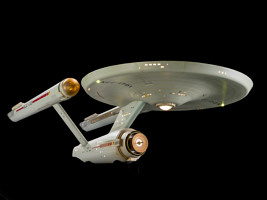
 Studio model after renovation
Studio model after renovation